“Trivially relocatable” versus “trivially destructible after move”
Recently I discovered that besides the various libraries using P1144-style (or occasionally P2786-style) trivial relocatability, there are also at least two that use P1029R2-style “trivial destructibility after move.”
Note: Not P1029R3-style “move = bitcopies”; that’s much closer to the union of both traits together.
This blog post demonstrates the difference between is_trivially_relocatable
and is_trivially_destructible_after_move.
Here are the two implementations of is_trivially_destructible_after_move of which
I’m aware:
-
Domagoj Šarić’s psiha/vm defines the trait
moved_out_value_is_trivially_destructible. -
Artur Bać’s arturbac/small_vectors defines the concept
concepts::relocatable.
Recall that the verb “relocate” means “take the object that used to be at src,
get rid of it, and make an object at dst with that same value.” Recall that this
is different from move-construction, and also different from move-assignment. Here’s
a Standard C++ definition of the P1144-alike library algorithm uninitialized_relocate.
(For simplicity, I’m assuming raw pointers instead of iterators, and omitting all
exception-safety and error-handling.)
template<class T>
T *raw_uninitialized_relocate(T *first, T *last, T *dfirst) {
T *dlast = std::uninitialized_move(first, last, dfirst);
std::destroy(first, last);
return dlast;
}
The two different traits let us add two different optimization codepaths, like this:
template<class T>
T *raw_uninitialized_relocate(T *first, T *last, T *dfirst) {
if constexpr (my::is_trivially_relocatable_v<T>) {
size_t n = last - first;
std::memmove((void*)dfirst, (void*)first, n * sizeof(T));
return dfirst + n;
} else if constexpr (my::is_trivially_destructible_after_move_v<T>) {
return std::uninitialized_move(first, last, dfirst);
} else {
T *dlast = std::uninitialized_move(first, last, dfirst);
std::destroy(first, last);
return dlast;
}
}
Only is_trivially_relocatable allows us to replace a whole swath of relocations with
memmove, because only is_trivially_relocatable says anything about the triviality
of the relocation operation as a whole. The optimization codepath for
is_trivially_destructible_after_move doesn’t involve memmove; it skips
the destructors of the moved-from elements, but it doesn’t have any insight into
what the move constructor might have done.
std::list illustrates the difference
Recall that there are two implementation strategies for the STL’s std::list.
-
The “sentinel-node” strategy, used by Microsoft STL. Every
listends with an additional allocated node, called the “sentinel.” Even a default-constructed (empty)listmanages a single heap-allocated sentinel node. -
The “dummy-node” strategy, used by libstdc++ and libc++. The
listobject itself contains a “dummy” node, consisting of only a prev/next pointer pair (no payload). Theback()node’s next pointer points at that dummy node, and the dummy node’s prev pointer points at the heap-allocatedback()node.
The relocation operation for each kind of list looks like this. (Lines with arrows
represent one-way pointers; lines without arrows represent two-way prev/next pairs.
The elements highlighted in red are created or updated by the move constructor.)
| Step | Sentinel node (MSVC) |
Dummy node (everyone else) |
|---|---|---|
Initial state:src holds {A,B,C} |
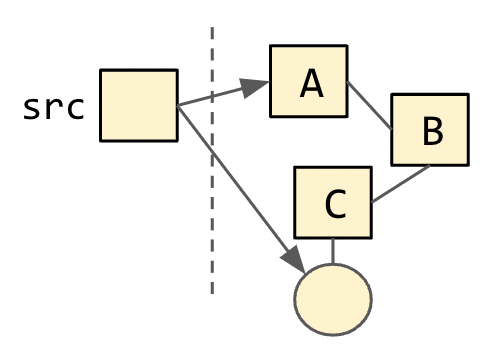 |
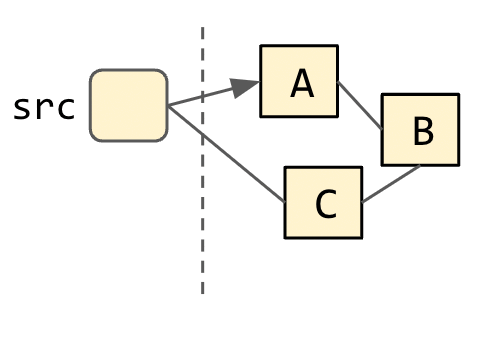 |
Move-constructdst from src |
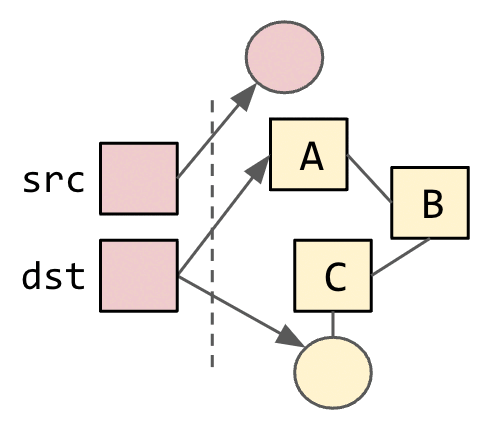 |
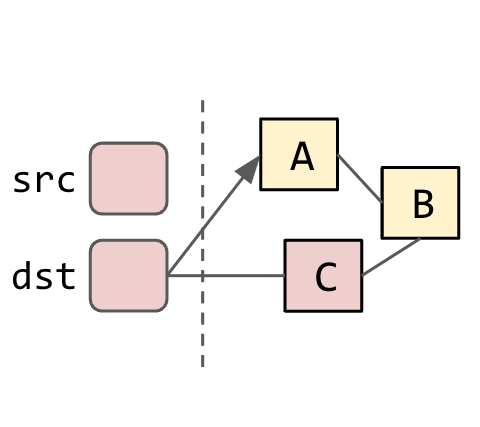 |
| Destroy the moved-from src |
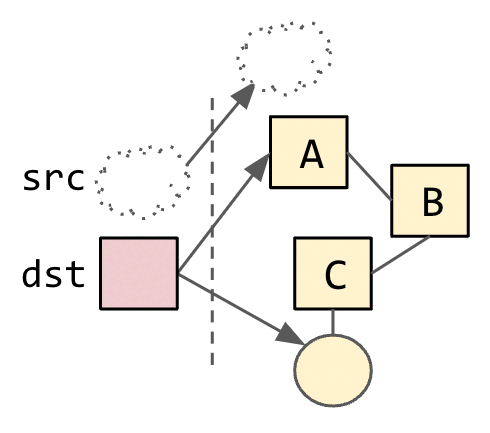 |
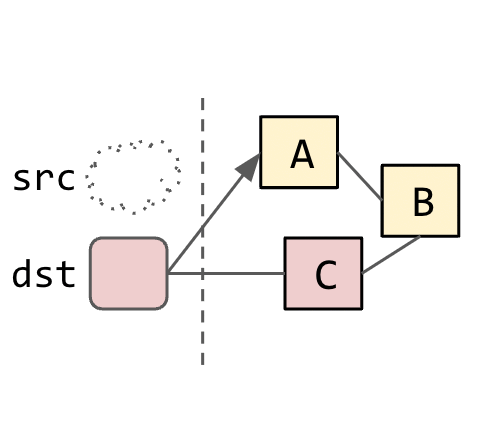 |
Notice that MSVC’s move-construction operation doesn’t need to touch any of the old heap-allocated nodes;
but it does need to allocate a new sentinel node for the moved-from src. Contrariwise, the dummy-node
implementation doesn’t allocate, but it does need to update node C’s next pointer to point to the
dummy node stored inside dst (where previously it pointed to the dummy node stored inside src).
Notice that in the dummy-node implementation we can safely skip the destructor of the moved-from src;
it no longer controls any resources. Contrariwise, in MSVC’s sentinel-node implementation, skipping
the destructor of src would leak memory.
Therefore:
-
In Microsoft STL,
is_trivially_relocatable<std::list<int>>istruebutis_trivially_destructible_after_move<std::list<int>>isfalse. -
In libc++ and libstdc++,
is_trivially_destructible_after_move<std::list<int>>istruebutis_trivially_relocatable<std::list<int>>isfalse.
Another example, and caveat
libstdc++’s deque has a “never-empty” invariant similar to MSVC’s list.
- In libstdc++,
is_trivially_relocatable<std::deque<int>>istruebutis_trivially_destructible_after_move<std::deque<int>>isfalse.
In fact, there’s a big caveat to mention at this point: many types (such as
for example libstdc++’s string) are trivially destructible after move construction
but not trivially destructible after move assignment!
std::string src = "this string heap-allocates";
std::string dst = "this string heap-allocates too";
dst = std::move(src);
assert(src.capacity() > std::string().capacity());
So if you’re thinking of using a trait like is_trivially_destructible_after_move,
you should consider your optimizations carefully: make sure you know what kind of
“move” operation you’re “after,” before assuming that it’s okay to skip a destructor call.
void inplace_vector<T>::operator=(inplace_vector&& rhs) {
size_t n = size();
if (n < rhs.size()) {
std::move(rhs.begin(), rhs.begin() + n, begin());
std::uninitialized_move(rhs.begin() + n, rhs.end(), begin() + n);
if constexpr (my::is_trivially_destructible_after_move<T>) {
// WRONG: we cannot skip the first n destructor calls!
} else {
std::destroy(rhs.begin(), rhs.end());
}
} ~~~~
}
The operator= above leaks memory when T is libstdc++’s string.
Finally, it should go without saying that none of this holds for operations that “move”
from type T into a different type U. For example, this code is dangerously buggy:
void transfer(T *src, U *dst) {
std::construct_at(dst, std::move(*src));
if constexpr (my::is_trivially_destructible_after_move<T>) {
// WRONG: we cannot skip this destructor call!
} else {
std::destroy_at(src);
}
}
because it leaks memory when:
using T = std::shared_ptr<int>;
struct U { U(const T&) {} };
